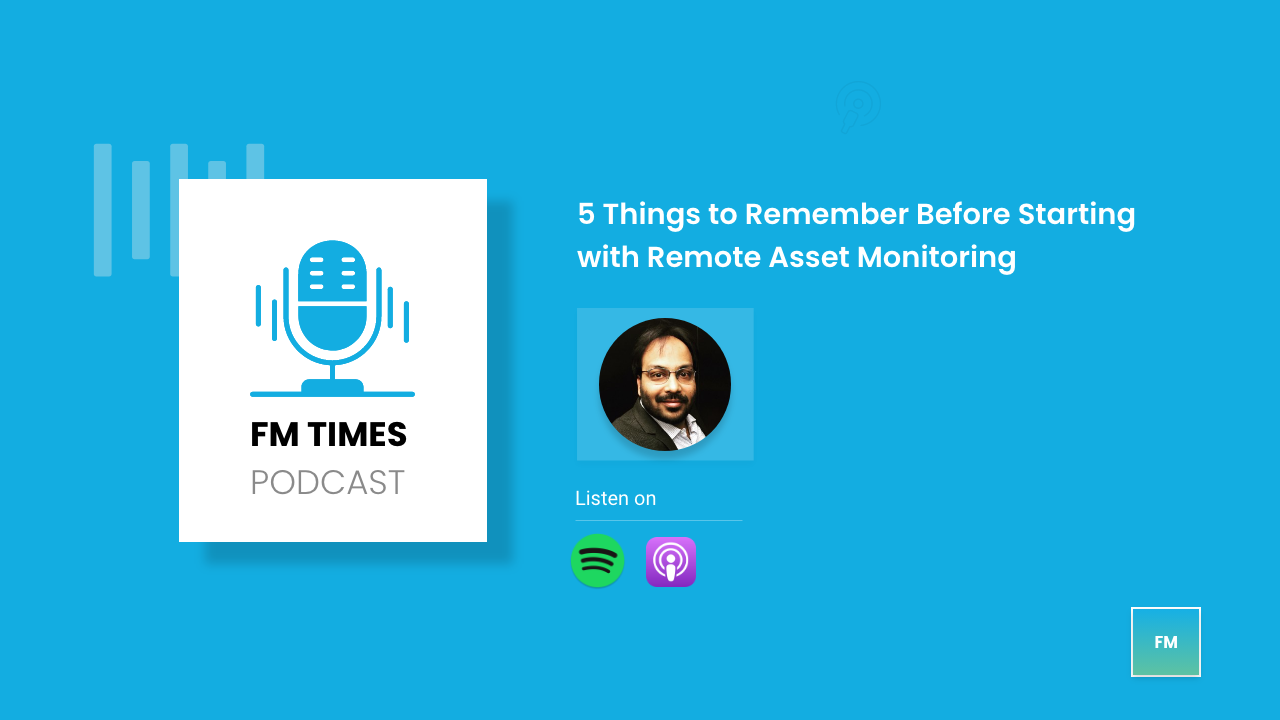This solo micro-podcast episode by Umesh Bhutoria, Founder & CEO, Xempla, lists 5 things you need to know before getting started with Remote Monitoring at your facilities. Even if you’ve already started, it would be a good checklist to go through to evaluate your current strategy.
We now live in a world where IoT-enabled remote monitoring is the “new normal,” and data technologies aid in better decision-making and asset optimization. Remote asset management has gained a lot of importance in the engineering and hard services space in facilities management, and its value in asset intensive industries is only growing.
Setting up a remote monitoring system is also one of the first steps to take if you’re looking at augmenting your current process of doing maintenance or running energy management services across the built environment. Remote asset monitoring brings in aspects like the Internet of Things (IoT), data collection devices (sensors) and enables gathering of real-time asset information from remote or off site locations. Thus, it has helped shoulder the rise of proactive facilities management methods like predictive maintenance of building assets.
But simply installing high-tech sensors and remote monitoring software is not enough to get results. You may have an idea of what features you want in a remote monitoring system, but putting one in place is challenging. To help you out, here are five things to remember before getting started with remote monitoring or to evaluate your existing strategy if you’ve already started:
#1 Plan carefully before you start
The first step, obviously, is to plan carefully before you start. What’s the end objective you want to achieve with remote asset monitoring? And what are those two to three key aspects that would help you lay down your assumptions and validate them? These can be hypothetical points that you are considering ticking off if the strategy were to become successful. Also, it will be wise to connect your remote monitoring strategy to the business value you’re looking to drive out of it.
#2 Keep it simple
Overcomplexity will dampen your efforts to set up a remote monitoring program, and it’s probably going to kill the entire thing even before it starts. Take our word for it. Focus on getting to a limited outcome over looking to get multiple outcomes, and you’re going to be far more successful. Seeking to resolve all your pain points at once is not a good strategy, especially when you’re just starting out with the program.
#3 Choose your asset mix wisely
Most of your engineers or on-ground maintenance staff would know this – not all assets are suited for remote monitoring. Choose a diverse mix of assets, the ones which are critical, along with the ones that are large in number, depending on the size and type of your facilities. For the critical ones, even if you become successful with your assumptions, you would still probably be a long way off in trying to move from your current scheduled regime to a more optimized regime.
The optimization would happen first for noncritical assets, and for critical assets, it would take a longer journey of learning and evaluation. We highly recommend that you pick a mix of non-critical assets, which are usually larger in number, and the critical ones to help you with the next step, which is determining success factors.
#4 Determine success factors
Put a good amount of effort into thinking about how all of this is going to augment or change your current process of monitoring assets. Suppose you look at a chart showing how you do things currently. And if you are to be successful with, let’s say, putting up those sensors or looking at building management system (BMS) data in a better way. How is it going to help your process become better, not just from the overall process perspective, but also from the perspective of all the steps involved.
Some potential examples could be –
- Under the current method, the team takes almost 30 minutes to look into BMS data as in when they need to. Can it be brought down?
- Teams do not typically look at any data from BMS or from any other data sources while evaluating or conducting maintenance procedures. Does this help them augment or improve maintenance procedures?
The idea is always to look for small gains, because they will eventually pave the way for bigger gains.
#5 Have the big picture in mind
Having the big picture in mind is really important for your remote monitoring program to be successful. At the end of the day, you are doing this not just to prove a concept, but to prove a value. This means you need to consider changes at the portfolio level, not just individual sites.
While it’s important to think about what scale could and would look like, you’re better off not evaluating this exercise with that perspective. Keep it at the back of your mind. Look at what’s working. Look at what’s not working. And then eventually make a call.
Remember these 5 things before getting started with remote asset monitoring:
Final Words
Given what’s happening around the world across the built environment, with a focus on sustainability and cost reduction, everyone has been thinking of getting started with remote monitoring. That’s the first step that you could take to enhance your asset performance management – even make facilities self-reliant.
If there’s anything else that you think should be kept in mind, or you’ve done something which has turned out to be very successful, we would love to know what it is!
Listen to the latest episodes from our FM Times Podcast series here.

Leave a Reply